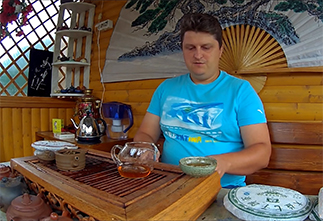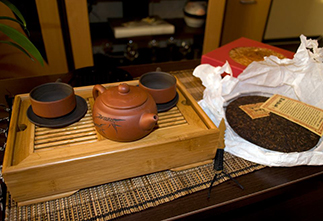Shu Puer 2016 "Ecological" from Yunfuxiang: a gift from nature Xishuangbanna
Shu Puer 2016 "Ecological" from the famous Yunfuxiang factory is an exquisite example of traditional Yunnan puer, created with care for nature and man. This tea, aged for eight years, has acquired a deep, rich taste and rich aroma that will be appreciated even by the most demanding connoisseurs.
History of creation and features
Yunfuxiang Tea Factory is famous for its high-quality pu-erhs, which are produced using traditional technologies. Shu Pu-erh "Ecological" is the result of many years of experience and skill of tea masters. To create it, raw materials grown in ecologically clean areas of the Xishuangbanna-Dai Autonomous Region were used. Careful fermentation in heaps allowed to obtain tea with a bright, rich taste and multifaceted aroma.
- Manufacturer: Yunfuxiang (云福祥, Yún fú xiáng) is one of the leading producers of pu-erh in China.
- Name: Menghai Ecological Pu'er, Pressed (Ripe)
- Raw materials: High-quality tea leaves grown in ecologically clean areas of Xishuangbanna.
- Fermentation: Traditional heap fermentation.
- Pressing: Pancake weighing 357 grams.
- Year of production: 2016.
Taste and aroma
Shu Puer "Ecological" has a deep, rich taste with notes of wood, earth and light sweetness. The aroma of tea is rich, with shades of nuts, chocolate and spices. A distinctive feature of this tea is its balance: it invigorates, but at the same time does not have excessive astringency or bitterness. The taste rather gravitates towards sweetness, but without cloying. Light earthiness gives the tea depth and richness.
Beneficial properties
Like other types of puer, Shu Puer "Ecological" has a number of useful properties:
- Improving digestion: Promotes normal digestion and metabolism.
- Toning the body: Increases vitality and vigor.
- Antioxidant properties: Protects the body's cells from the harmful effects of free radicals.
- Beneficial effects on the cardiovascular system: Helps lower cholesterol levels and improve blood circulation.
How to brew
To brew this puer, it is recommended to use a Yixing clay teapot or porcelain gaiwan. The water temperature should be about 95°C. 7-10 grams of dry tea leaves are enough for one brewing.
Why is it worth trying this pu-erh?
- High Quality: Produced by one of the best Chinese tea factories.
- Eco-friendly: The raw materials are grown in the ecologically clean areas of Xishuangbanna.
- Balanced taste: Combines vigor and sweetness.
- Beneficial properties: Has a beneficial effect on the body as a whole.
- Storage Potential: Shu pu-erhs only get better with age, making this tea a great investment.
Shu Puer 2016 "Ecological" from Yunfuxiang is a real gift for puer lovers. Its deep, rich taste and rich aroma, as well as its environmentally friendly composition make it unforgettable. This tea will be a great addition to your tea collection and will give you unforgettable moments of enjoyment.
|
Name in Chinese
|
勐海生态茶 普洱紧压茶 (熟茶) |
|
Pinyin
|
měnghǎi shēngtài chá pǔ'ěr jǐnyāchá (shúchá) |
|
Translation
|
Ecological Puer Tea from Menghai (Black Puer) |
|
Country
|
China |
|
District
|
Xishuangbanna Dai Autonomous Prefecture |
|
Provinces
|
Yunnan (云南) |
|
Manufacturer
|
Юньфусян (云福祥) |
- Комментарии
- Вконтакте
Pu-erh is one of the most unique types of tea, which only gets better with age. Many people, when they first encounter this tea, wondered: why is pu-erh more often found in pressed form (cakes, bricks, tochas), and not in loose form? The reasons for this are related to both history and the practical aspects of storing and fermenting tea. Despite modern technologies that allow the production of loose pu-erh, the shape of pressed cakes remains unchanged. And pu-erh is more often found on sale in pressed form, for example, in the form of cakes or bricks, and loose pu-erh is less common. We will talk about the reasons for pressing pu-erh into cakes in this article.
Puer is a unique Chinese tea that is distinguished by its depth of taste, complexity of aromas and versatility of aftertaste. Its taste characteristics are formed under the influence of many factors, from growing conditions to the brewing method. Let's look at the main ones.
The question often arises: how to brew puerh correctly? Sometimes the phrase "to get high" is added to it. Moreover, everyone has their own understanding of this phrase. Some mean vigor, and some - intoxication. So how to brew puerh tea correctly? Let's consider several options.
Traveling through the tea mountains, we found ourselves in another land of blue roofs - the village of Zhongcai, which is located in the Menghai district of Yunnan province. According to tradition, we were shown another local tea tree, which, according to the Chinese, is at least a million years old :) The village is very authentic, not designed for tourists, there are many wild pu-erhs there and, of course, we were warmly received. They treated us to local cuisine and tea. We also asked the residents about the prices of tea and how they have changed in recent years.
The tea ceremony occupies a special place in the centuries-old Eastern tradition. And although the essence of this phenomenon remains constant, the nature and external manifestations of the tea ceremony in different nations have their own national characteristics. In each Chinese province, the tea ceremony and the tea used in it are varied: for example, residents of the southern provinces prefer green tea, and residents of the northern provinces - red tea, in Fujian province they more often use Oolong tea, and in Yunnan province Puer tea is widely known.

























































































